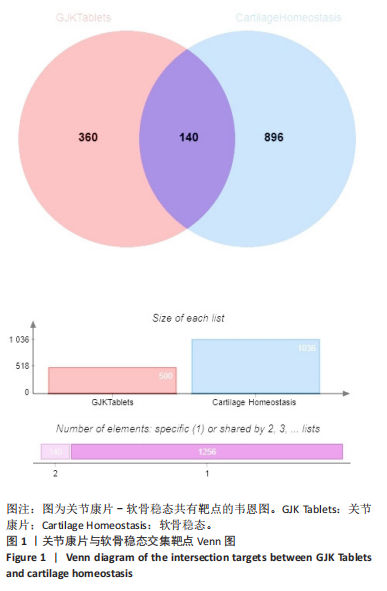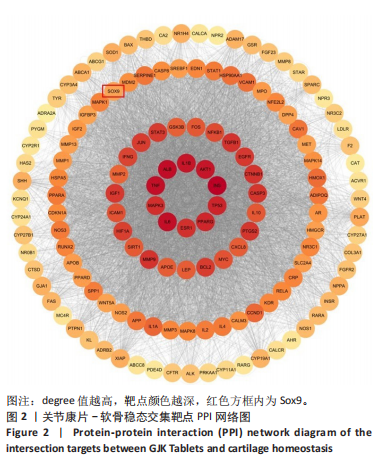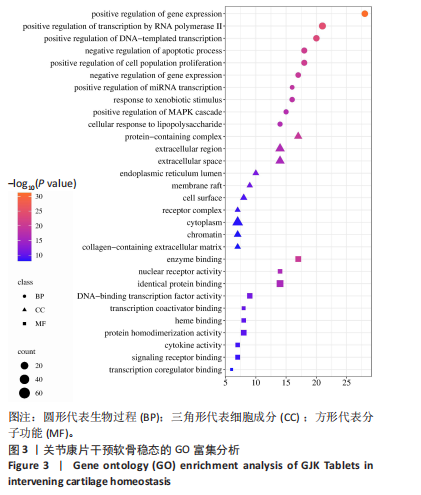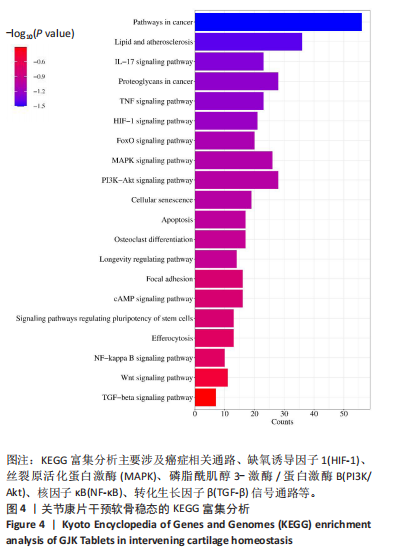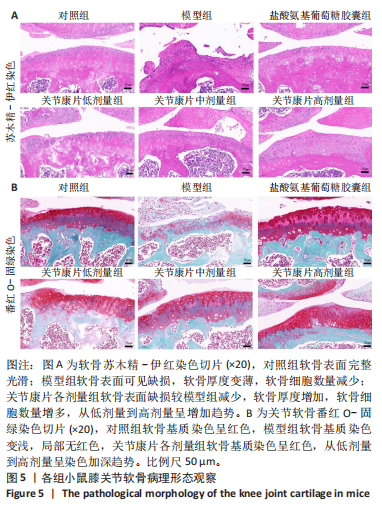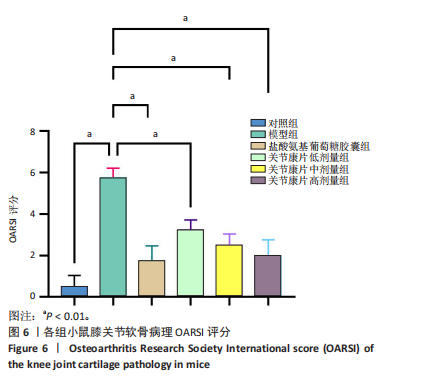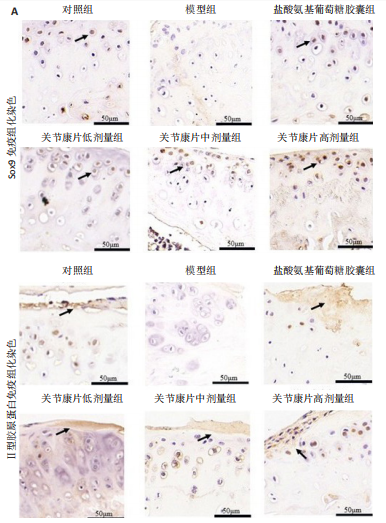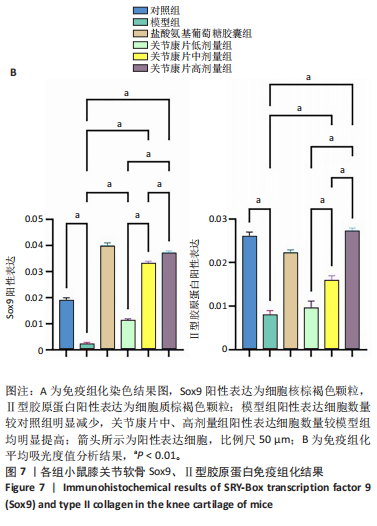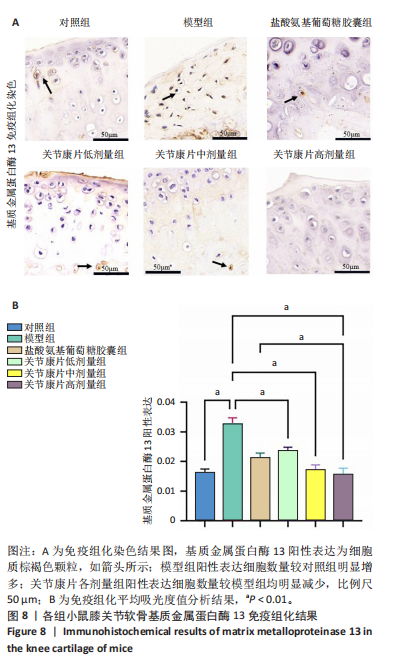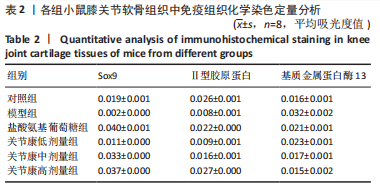[1] GELBER AC. Knee Osteoarthritis. Ann Intern Med. 2024;177(9):ITC129-ITC144.
[2] YAO Q, WU X, TAO C, et al. Osteoarthritis: pathogenic signaling pathways and therapeutic targets. Signal Transduct Target Ther. 2023; 8(1):56.
[3] PENG Z, SUN H, BUNPETCH V, et al. The regulation of cartilage extracellular matrix homeostasis in joint cartilage degeneration and regeneration. Biomaterials. 2021;268:120555.
[4] SHAO R, SUO J, ZHANG Z, et al. H3K36 methyltransferase NSD1 protects against osteoarthritis through regulating chondrocyte differentiation and cartilage homeostasis. Cell Death Differ. 2024;31(1):106-118.
[5] SHARMA L. Osteoarthritis of the Knee. N Engl J Med. 2021;384(1):51-59.
[6] GIORGINO R, ALBANO D, FUSCO S, et al. Knee Osteoarthritis: Epidemiology, Pathogenesis, and Mesenchymal Stem Cells: What Else Is New? An Update. Int J Mol Sci. 2023;24(7):6405.
[7] 傅永升, 谭茗月, 王卫国, 等. 中药调控膝骨关节炎相关信号通路的研究进展[J].中国实验方剂学杂志,2023,29(22):231-243.
[8] 陈丹丹, 武晏屹, 姬叔梅, 等. 基于文献分析的治疗膝骨关节炎中药应用规律分析[J].中药药理与临床,2022,38(4):186-191.
[9] 李晓峰, 刘元禄, 关雪峰, 等. 补肾活血方剂治疗膝骨关节炎研究进展[J]. 辽宁中医药大学学报,2023,25(10):142-146.
[10] 杨浩宇, 王世坤, 杨东元, 等.补肾活血中药治疗膝骨性关节炎与骨质疏松症“共病”机制研究进展[J].中草药,2024,55(11):3898-3905.
[11] 唐立明, 李鹏飞, 庞智晖, 等. 樊粤光治疗膝骨性关节炎经验介绍[J].新中医,2017,49(5):146-147.
[12] 梁笃, 樊粤光, 王海彬. 关节康治疗膝骨性关节炎22例临床观察[J]. 新中医,2009,41(6):59-60.
[13] 梁笃, 樊粤光, 王海彬. 关节康结合关节镜技术治疗膝骨性关节炎23例[J]. 江西中医药,2009,40(7):28-30.
[14] 曹厚然, 冯文俊, 陈昭, 等. 关节康片调控白细胞介素6表达促进膝关节损伤修复的机制及相关生物标志物的测定[J]. 广州中医药大学学报,2020,37(11):2210-2218.
[15] 周斌, 樊粤光, 曾意荣. 中药关节康对骨性关节炎软骨TGF-β1、IL-1β表达的影响[J]. 中国中医骨伤科杂志,2009,17(2):11-13.
[16] 梁笃, 樊粤光, 王海彬, 等. 关节康中药血清促进去分化软骨细胞再分化的实验研究[J]. 新中医,2009,41(4):101-103.
[17] FUJII Y, LIU L, YAGASAKI L, et al. Cartilage Homeostasis and Osteoarthritis. Int J Mol Sci. 2022;23(11):6316.
[18] ZHANG X, WU S, ZHU Y, et al. Exploiting Joint-Resident Stem Cells by Exogenous SOX9 for Cartilage Regeneration for Therapy of Osteoarthritis. Front Med (Lausanne). 2021;8:622609.
[19] MUTHU S, KORPERSHOEK JV, NOVAIS EJ, et al. Failure of cartilage regeneration: emerging hypotheses and related therapeutic strategies. Nat Rev Rheumatol. 2023;19(7):403-416.
[20] YEE JL, HUANG CY, YU YC, et al. Potential Mechanisms of Guizhi Fuling Wan in Treating Endometriosis: An Analysis Based on TCMSP and DisGeNET Databases. J Ethnopharmacol. 2024;329:118190.
[21] KONG X, LIU C, ZHANG Z, et al. BATMAN-TCM 2.0: an enhanced integrative database for known and predicted interactions between traditional Chinese medicine ingredients and target proteins. Nucleic Acids Res. 2024;52(D1):D1110-D1120.
[22] PESARE E, VICENTI G, KON E, et al. Italian Orthopaedic and Traumatology Society (SIOT) position statement on the non-surgical management of knee osteoarthritis. J Orthop Traumatol. 2023;24(1):47.
[23] HERRERO-BEAUMONT G,LARGO R.Glucosamine and O-GlcNAcylation:a novel immunometabolic therapeutic target for OA and chronic, low-grade systemic inflammation? Ann Rheum Dis. 2020;79(10):1261-1263.
[24] 程丽丽, 黄传兵, 陈君洁, 等. 重骨颗粒干预膝骨关节炎大鼠细胞焦亡的机制[J].中国骨质疏松杂志,2024,30(9):1317-1322.
[25] Ji X, Du W, Che W, et al. Apigenin Inhibits the Progression of Osteoarthritis by Mediating Macrophage Polarization. Molecules. 2023;28(7):2915.
[26] ZHU S, QU W, HE C. Evaluation and management of knee osteoarthritis.J Evid Based Med. 2024;17(3):675-687.
[27] COURTIES A, KOUKI I, SOLIMAN N, et al. Osteoarthritis year in review 2024: Epidemiology and therapy. Osteoarthritis Cartilage. 2024; 32(11):1397-1404.
[28] YOU B, ZHOU C, YANG Y. MSC-EVs alleviate osteoarthritis by regulating microenvironmental cells in the articular cavity and maintaining cartilage matrix homeostasis. Ageing Res Rev. 2023;85:101864.
[29] LIU X, JIANG S, JIANG T, et al. Bioenergetic-active exosomes for cartilage regeneration and homeostasis maintenance. Sci Adv. 2024; 10(42):eadp7872.
[30] WANG Z, EFFERTH T, HUA X, et al. Medicinal plants and their secondary metabolites in alleviating knee osteoarthritis: A systematic review. Phytomedicine. 2022;105:154347.
[31] ZENG L, ZHOU G, YANG W, et al. Guidelines for the diagnosis and treatment of knee osteoarthritis with integrative medicine based on traditional Chinese medicine. Front Med (Lausanne). 2023;10:1260943.
[32] 李慧, 周祥, 刘伟, 等. 补肾活血法治疗膝关节骨性关节炎机制研究进展[J]. 实用中医药杂志,2024,40(5):1027-1030.
[33] 陈继鑫, 周沁心, 余伟杰, 等. 补肾活血法治疗膝骨关节炎随机对照试验结局指标的现状分析[J]. 中国中药杂志,2024,49(6):1661-1672.
[34] KIM SM, JO SY, PARK HY, et al. Investigation of Drug-Interaction Potential for Arthritis Dietary Supplements:Chondroitin Sulfate, Glucosamine,and Methylsulfonylmethane. Molecules. 2023;28(24):8068.
[35] MENG Z, LIU J, ZHOU N. Efficacy and safety of the combination of glucosamine and chondroitin for knee osteoarthritis: a systematic review and meta-analysis. Arch Orthop Trauma Surg. 2023;143(1):409-421.
[36] RABADE A, VISWANATHA GL, NANDAKUMAR K, et al. Evaluation of efficacy and safety of glucosamine sulfate, chondroitin sulfate, and their combination regimen in the management of knee osteoarthritis: a systematic review and meta-analysis. Inflammopharmacology. 2024;32(3):1759-1775.
[37] ROELOFS AJ, DE BARI C. Osteoarthritis year in review 2023: Biology.Osteoarthritis Cartilage. 2024;32(2):148-158.
[38] ARAI Y, CHA R, NAKAGAWA S, et al. Cartilage Homeostasis under Physioxia. Int J Mol Sci. 2024;25(17):9398.
[39] TAHEEM DK, JELL G, GENTLEMAN E.Hypoxia Inducible Factor-1alpha in Osteochondral Tissue Engineering. Tissue Eng Part B Rev. 2020; 26(2):105-115.
[40] LU R, WANG YG, QU Y, et al. Dihydrocaffeic acid improves IL-1beta-induced inflammation and cartilage degradation via inhibiting NF-kappaB and MAPK signalling pathways. Bone Joint Res. 2023;12(4):259-273.
[41] TIAN B, ZHANG L, ZHENG J, et al. The role of NF-kappaB-SOX9 signalling pathway in osteoarthritis. Heliyon. 2024;10(17):e37191.
[42] KLAMPFLEUTHNER F, LOTZ B, RENKAWITZ T, et al.Stage-Dependent Activity and Pro-Chondrogenic Function of PI3K/AKT during Cartilage Neogenesis from Mesenchymal Stromal Cells. Cells. 2022;11(19):2965.
[43] XU R, WU J, ZHENG L, et al. Undenatured type II collagen and its role in improving osteoarthritis. Ageing Res Rev. 2023;91:102080.
[44] SONG H, PARK KH. Regulation and function of SOX9 during cartilage development and regeneration. Semin Cancer Biol. 2020;67(Pt 1):12-23.
[45] DANALACHE M, UMRATH F, RIESTER R, et al. Proteolysis of the pericellular matrix: Pinpointing the role and involvement of matrix metalloproteinases in early osteoarthritic remodeling. Acta Biomater. 2024;181:297-307.
[46] HU Q, ECKER M. Overview of MMP-13 as a Promising Target for the Treatment of Osteoarthritis. Int J Mol Sci. 2021;22(4):1742.
[47] OUYANG Y, WANG W, TU B, et al. Overexpression of SOX9 alleviates the progression of human osteoarthritis in vitro and in vivo. Drug Des Devel Ther. 2019;13:2833-2842.
[48] SHAO Y, ZHANG H, GUAN H, et al. PDZK1 protects against mechanical overload-induced chondrocyte senescence and osteoarthritis by targeting mitochondrial function. Bone Res. 2024;12(1):41.
[49] FU B, SHEN J, ZOU X, et al. Matrix stiffening promotes chondrocyte senescence and the osteoarthritis development through downregulating HDAC3. Bone Res. 2024;12(1):32.
[50] SUN Y, YOU Y, WU Q, et al. Senescence-targeted MicroRNA/Organoid composite hydrogel repair cartilage defect and prevention joint degeneration via improved chondrocyte homeostasis. Bioact Mater. 2024;39:427-442.
[51] GUAN Z, JIN X, GUAN Z, et al. The gut microbiota metabolite capsiate regulate SLC2A1 expression by targeting HIF-1alpha to inhibit knee osteoarthritis-induced ferroptosis. Aging Cell. 2023;22(6):e13807.
[52] LIU J, JIA S, YANG Y, et al. Exercise induced meteorin-like protects chondrocytes against inflammation and pyroptosis in osteoarthritis by inhibiting PI3K/Akt/NF-kappaB and NLRP3/caspase-1/GSDMD signaling. Biomed Pharmacother. 2023;158:114118.
[53] ZHANG Z, MA J, YI Y, et al. Isoliensinine suppresses chondrocytes pyroptosis against osteoarthritis via the MAPK/NF-kappaB signaling pathway. Int Immunopharmacol. 2024;143(Pt 3):113589.
[54] WANG L, XU H, LI X, et al. Cucurbitacin E reduces IL-1beta-induced inflammation and cartilage degeneration by inhibiting the PI3K/Akt pathway in osteoarthritic chondrocytes. J Transl Med. 2023;21(1):880.
[55] LIU L, ZHAO C, ZHANG H, et al. Asporin regulated by miR-26b-5p mediates chondrocyte senescence and exacerbates osteoarthritis progression via TGF-beta1/Smad2 pathway. Rheumatology (Oxford). 2022;61(6):2631-2643.
[56] PRIMORAC D, MOLNAR V, MATISIC V, et al.Comprehensive Review of Knee Osteoarthritis Pharmacological Treatment and the Latest Professional Societies’ Guidelines. Pharmaceuticals (Basel). 2021; 14(3):205.
|
